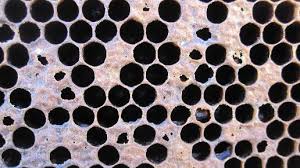American Foulbrood in Honeybee: Symptoms and Management
The spore-forming bacterium Paenibacillus larvae causes American foulbrood (AFB), a deadly bacterial disease of honey bee brood. It is not a stress-related illness and can infect colonies ranging from the strongest to the weakest in an apiary. Adult bees are immune to infection and only the immature larvae are vulnerable. Once an individual larva becomes infected, the entire brood of the colony might become sick. When infected brood reaches the pre-pupal or pupal stage, it usually dies. Heavy infections can impact the majority of the brood, severely weakening and finally destroying the colony. The colony will not be able to generate enough young workers in time, resulting in the colony’s weakening and eventual death. Because the disease cannot be treated, the only approach to handle AFB is to destroy infected colonies and hives or irradiate infected material.
Although AFB is not extremely infectious, bacterial spores can easily travel between hives and apiaries via beekeeping activities such as equipment exchange and transportation of contaminated combs. Adult bees are not harmed by AFB, however robbing and drifting can transport spores inside and between infected and clean hives.
AFB spores may live for more than 50 years and thus are extremely resistant to freezing and high temperatures. As a result, the only approach to treat the illness is to prevent infections by using beekeeping best management practices, and if an AFB outbreak does occur, to deal with it quickly before other colonies get contaminated.
The ingestion of Paenibacillus larvae spores infects young larvae. Ingested spores germinate and multiply inside the larva’s midgut, eventually breaking through the midgut epithelium and killing the larva. The tissues of sick larvae deteriorate in sealed brood cells if not removed by nursing bees’ hygienic behavior. Later, the larvae dry down to hard black scales that are difficult for worker bees to clean up and contain up to two million spores that are extremely contagious to other larvae. If the disease is not diagnosed in time, it can rapidly spread. Paenibacillus larval spores are highly resistant to disinfection and can live for up to 30 years.
Symptoms of American Foulbrood:
Many honey bee pests and diseases appear when the colony is stressed, such as a lack of nectar or pollen, unfavorable weather conditions, a poor functioning queen bee, or an infection with other pests or diseases. This is not true for American foulbrood. AFB may infect both healthy and weaker colonies and can occur at any time of year. If nursing bees feed AFB spores to early larvae, these larvae will die after capping. After that, the bacteria may proliferate rapidly, creating billions of spores. The nursing bees try to clear away the sick pupae, but in doing so, they become carriers for the illness and infect new young larvae when they feed them.

Typical symptoms of American foulbrood include:
- Brood pattern is irregular and spotty.
- Infected brood cell capping’s may seem sunken, deeper in color, or greasy. This is due to the larvae inside rotting.
- Bees trying to remove dead brood may potentially perforate the cappings (the remains of which are infective).
- After capping, the larvae die and turn into a light to dark brown semi-liquid mass.
- Due of the rotting brood, infected hives may also have a sulfide odour.
Management of American Foulbrood:
The only strategy to control AFB is to avoid infection by using good beekeeping practices, and if an AFB outbreak does occur, to deal with it quickly before further colonies get infected. As a result, beekeepers should constantly keep the following management strategies in mind, which describe what to do and what not to do to help reduce AFB. The emphasis should be on disease prevention through proper beekeeping practices and prophylaxis.
- Introducing “foreign” bees, beekeeping products, and material into a colony or apiary should be done with extreme caution.
- Robbery should be avoided.
- All colonies (especially the brood) should be inspected for abnormalities on a regular basis.
- Brood combs should be replaced on a regular basis.
- There are numerous ways to eliminate these colonies in the event of an outbreak, but the most common is to seal them in the evening, when all honey bees are inside, and then kill them (e.g., using sulphur dioxide). Following that, the colonies (bees and stuff) are burned.
- Recently, USDA has approved a prophylactic vaccine for AFB developed by Dalan Animal Health. The vaccine is incorporated into royal jelly, a sugar feed given to queen bees. Once they ingest it, the vaccine is then deposited in their ovaries, giving developing larvae immunity as they hatch.
The honey from affected colonies may contain massive numbers of spores. Because these spores are not hazardous to humans, the honey can still be consumed. Spore contaminated honey, on the other hand, should never be fed to honey bees. Antibiotic therapy is not a viable option. Antibiotics are ineffective against the extremely resistant spores.

